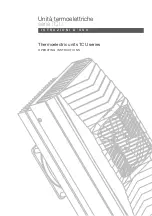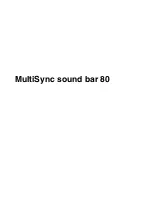
142
En
Glossary
■
LFE 0.1 channel
This channel reproduces low-frequency signals. The frequency
range of this channel is from 20 Hz to 120 Hz. This channel is
counted as 0.1 because it only enforces a low-frequency range
compared to the full-range reproduced by the other 5/6 channels
in Dolby Digital or DTS 5.1/6.1-channel systems.
■
MP3
One of the audio compression methods used by MPEG. It
employs the irreversible compression method, which achieves a
high compression rate by thinning out the data of hardly audible
part to the human ears. It is said to be capable of compressing the
data quantity by about 1/11 (128 kbps) while maintaining a
similar audio quality to music CD.
■
MPEG-4 AAC
An MPEG-4 audio standard. As it allows compression of data at a
bit rate lower than that of MPEG-2 AAC, it is used among others
for mobile telephones, portable audio players and other low-
capacity devices requiring high sound quality.
In addition to the above types of devices, MPEG-4 AAC is also
used to distribute contents on the Internet, and as such is
supported by computers, media servers and many other devices.
■
Neo:6
Neo:6 decodes the conventional 2-channel sources for 6- channel
playback by the specific decoder. It enables playback with the
full-range channels with higher separation just like digital
discrete signal playback. There are two modes available: “Music
mode” for music sources and “Cinema mode” for movie sources.
■
Neural-THX Surround
“Neural-THX” Surround is taking surround sound to the next
level. This revolutionary new technology delivers the rich
envelopment and discrete image detail of surround sound in a
format that is fully compatible with stereo. Neural-THX Surround
reduces the bandwidth needed for broadcasters to deliver true,
multi-channel surround presentations, and enables 7.1-channel
support for gaming and movies. By unmasking the audio details,
typically lost by other playback systems, audiences will
experience the deep ambience and subtle details of movies, music
and games. And with this technology being used by sound
designers during content creation, as well as embedded into
playback devices, Neural-THX Surround promises a listening
experience that is true to the original mix. Neural-THX Surround
has been chosen as the official surround sound broadcast format
for XM Satellite Radio’s “XM HD Surround”, as well as other
leading FM/HD radio stations worldwide. For additional
information, please visit http://www.neuralsurround.com/.
■
PCM (Linear PCM)
Linear PCM is a signal format under which an analog audio
signal is digitized, recorded and transmitted without using any
compression. This is used as a method of recording CDs and
DVD audio. The PCM system uses a technique for sampling the
size of the analog signal per very small unit of time. Standing for
“Pulse Code Modulation”, the analog signal is encoded as pulses
and then modulated for recording.
■
Sampling frequency and number of
quantized bits
When digitizing an analog audio signal, the number of times the
signal is sampled per second is called the sampling frequency,
while the degree of fineness when converting the sound level into
a numeric value is called the number of quantized bits. The range
of rates that can be played back is determined based on the
sampling rate, while the dynamic range representing the sound
level difference is determined by the number of quantized bits. In
principle, the higher the sampling frequency, the wider the range
of frequencies that can be played back, and the higher the number
of quantized bits, the more finely the sound level can be
reproduced.
■
SRS CS II (SRS Circle Surround II™)
SRS CS II (SRS Circle Surround II) is a high-performance
6.1 channel matrix surround sound decoding system. It is the
next-generation of the original SRS Circle Surround technology,
incorporating powerful industry-first features including the dialog
clarity enhancement technology and added cinema-like bass to
the front channels and subwoofer.
■
S-video signal
With the S-video signal system, the video signal normally
transmitted using a pin cable is separated and transmitted as the Y
signal for the luminance and the C signal for the chrominance
through the S-video cable. Using the
S VIDEO jack eliminates video signal transmission loss and
allows recording and playback of even more beautiful images.
■
WAV
Windows standard audio file format, which defines the method of
recording the digital data obtained by converting audio signals. It
does not specify the compression (coding) method so a desired
compression method can be used with it. By default, it is
compatible with the PCM method (no compression) and some
compression methods including the ADPCM method.
■
WMA
An audio compression method developed by Microsoft
Corporation. It employs the irreversible compression method,
which achieves a high compression rate by thinning out the data
of hardly audible part to the human ears. It is said to be capable of
compressing the data quantity by about 1/22 (64 kbps) while
maintaining a similar audio quality to music CD.
■
“x.v.Color”
A color space standard supported by HDMI version 1.3. It is a
more extensive color space than sRGB, and allows the expression
of colors that could not be expressed before. While remaining
compatible with the color gamut of sRGB standards, “x.v.Color”
expands the color space and can thus produce more vivid, natural
images. It is particularly effective for still pictures and computer
graphics.
















































